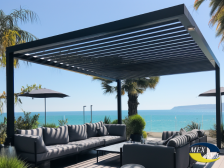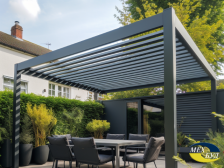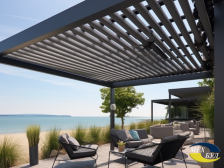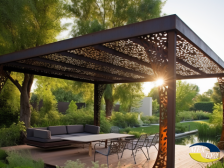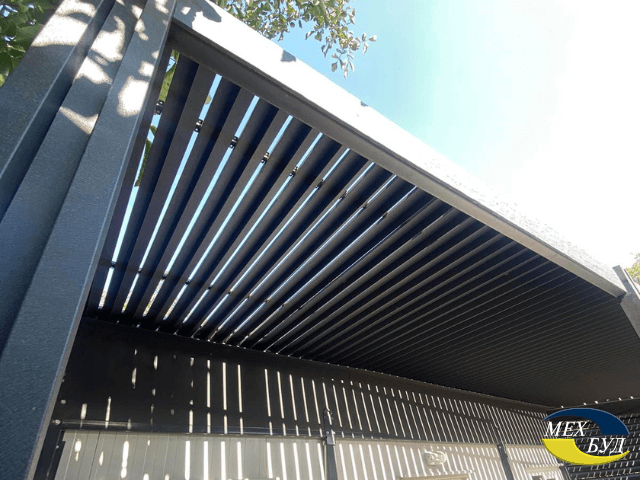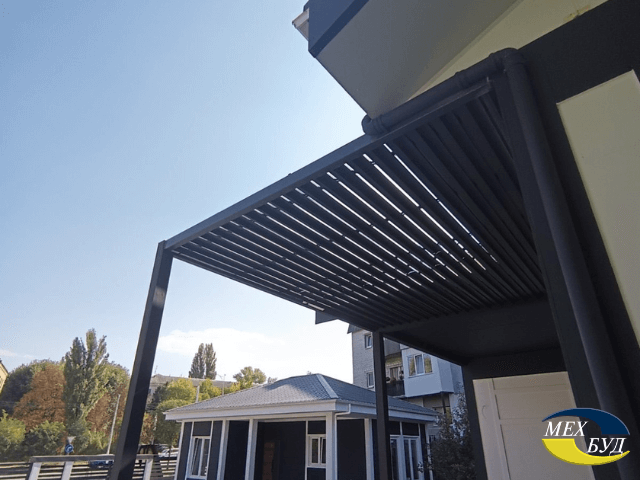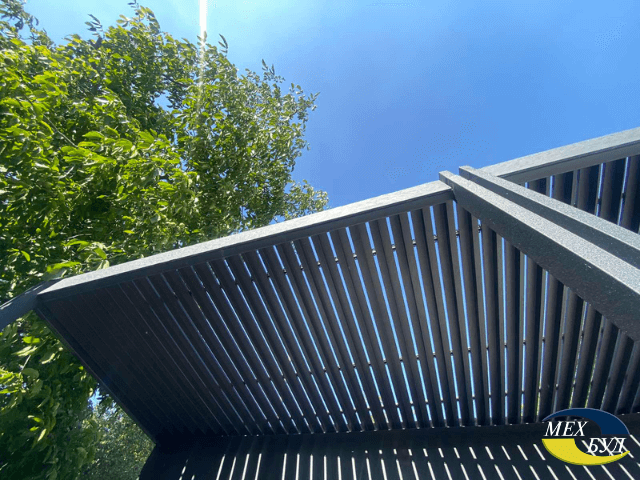Suspended Ceiling for Terrace
An open or partially enclosed (partially or fully glazed) terrace is an excellent place to relax during the warm season. Such terraces are arranged by both private homeowners and commercial property owners, primarily cafes and restaurants. A small canopy can be placed above the terrace, partially covering it, or a ceiling can fully cover the terrace – but in any case, such a structure needs finishing from the interior.
In almost 100% of cases, a suspended ceiling is chosen as the main solution. Such ceilings are easy to install, create minimal load on the supporting structure, and allow for the concealment of utilities. The latter is crucial for terraces: since there are no walls in such constructions, utilities (air ducts of heating and ventilation systems, wires, etc.) need to be hidden under the ceiling.
REQUIREMENTS FOR SUSPENDED TERRACE CEILING
When choosing the material and structural solution for a suspended ceiling, two main regulatory documents should be followed:
- SNiP 3.04.01-87 “Insulation and Finishing Coatings”
- SNiP 21-01-97 “Fire Safety of Buildings and Structures”
In addition to these, there are several other documents, but most of the requirements in these standards are duplicated or less stringent compared to the mentioned SNiPs.
If we briefly systematize the list of regulatory requirements and the practice of installing such ceilings, the list of requirements for them will be approximately as follows:
- High mechanical strength.
- Resistance to external influences (especially relevant for terraces without glazing).
- Maintaining geometry under load (minimal tendency to sag under its own weight).
- Possibility of installation at different distances from the supporting structure (utilities will be placed in the gap).
- Fire resistance (terraces in public buildings and commercial properties need to be finished with materials that do not ignite or support combustion).
- Aesthetic appearance.
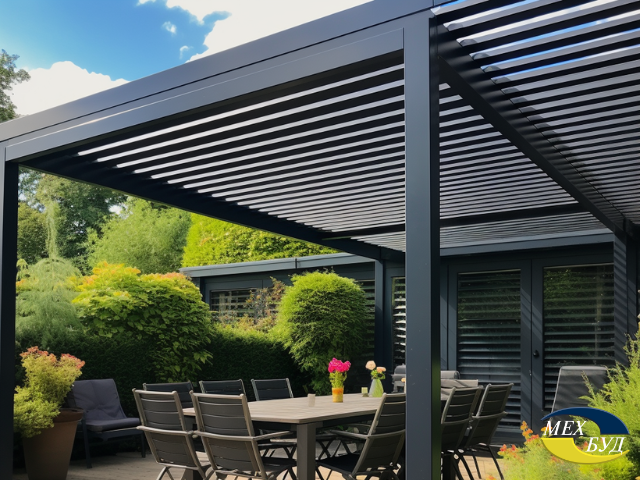
TYPES OF SUSPENDED CEILING SOLUTIONS
Before choosing the material from which the ceiling of an open terrace of a country house should be made, it is necessary to understand what types of suspended ceiling solutions the modern market offers.
The following varieties of materials are most commonly used for finishing terrace ceilings:
- PVC panels.
- Wood-based materials – natural wood, MDF, and composite.
- Metal panels.
- Let’s briefly characterize each of the mentioned varieties.
PLASTIC
One of the most affordable options is plastic lining. It has its advantages, which make it popular among consumers:
- good decorative properties,
- ease of installation,
- relative durability,
- resistance to rodents,
- easy maintenance.
But when choosing plastic for a terrace ceiling, it is important to remember the disadvantages of such a ceiling:
- it is sensitive to temperature fluctuations,
- deforms under the influence of heating devices;
- fragile, easily cracks during dismantling;
- fades in sunlight and is highly flammable.
So, it will be time to address the next “ceiling issue” very soon.

WOOD-BASED MATERIALS
For those who appreciate naturalness, wood is undoubtedly the go-to choice. Wooden lining:
- is durable,
- eco-friendly,
- allows for good air circulation,
- provides ample room for design solutions – from choosing the type of wood to various visual effects achieved by different arrangements of slats on the ceiling.
However, this option of suspended ceiling for a terrace has its significant drawbacks:
- Wood, being a natural material, reacts to temperature changes.
- It can dry out or, conversely, absorb moisture.
- Cracks may appear.
- To keep such a ceiling in good condition for a long time, it requires constant care, time, and, undoubtedly, money.
Apart from natural wood, other materials can also be used for terrace finishing:
- MDF panels – lining made of cellulose fiber with paper cladding. Despite visually resembling natural wood, MDF panels are significantly inferior in strength to solid boards. Additionally, even when treated with special compounds, MDF is susceptible to water, swelling in a humid environment, and lacks high fire resistance.
METAL SUSPENDED CEILING FOR TERRACES
A metal suspended ceiling for terraces is a successful combination of the advantages of its competitors and the practical exclusion of the aforementioned disadvantages.
This is due to the high quality of materials — galvanized steel with a polymer coating, stainless steel, and aluminum, from which suspended ceilings are manufactured at the “Mehbud” factory.
A metal suspended ceiling blends perfectly with all types of lighting, which is important when creating a modern interior.
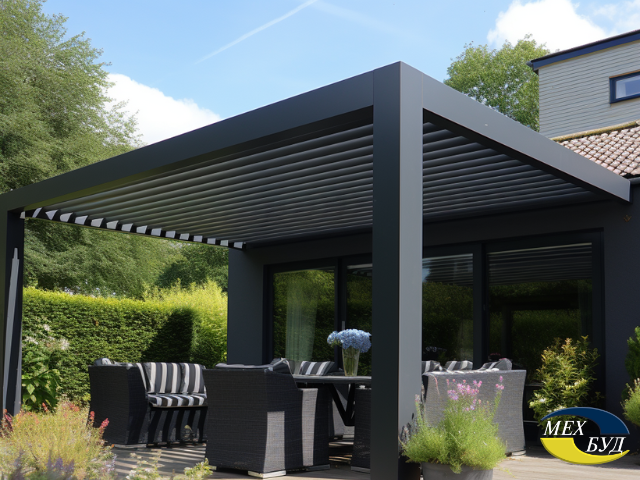
TYPES OF SUSPENDED CEILINGS FOR TERRACES
The range of ceiling structures available for order at the “MehBud” factory may complicate the choice of the appropriate variety. In reality, everything is quite simple: the necessary option is primarily determined by the operating conditions and the requirements for the appearance.
Which metal suspended ceiling to choose?
- The obvious solution for small terraces is louvered ceilings. They are neat, practical, and durable, and in addition, the louvered structure visually looks the same as a ceiling lined with boards. At the same time, louvered suspended ceilings have all the advantages of metal products — they do not deform under their own weight and withstand moisture and high temperatures well.

- Cassette and panel ceilings will be suitable for spacious terraces in commercial buildings. The use of large-format ceiling cassettes will allow for finishing a large area of the ceiling with minimal time and cost.

ADVANTAGES OF METAL SUSPENDED CEILINGS FOR TERRACES
- Durability: The appearance of metal panels remains unchanged after frosty winters, rainy autumns, and hot summers. Metal panels do not fade, crack, or deform. The warranty for metal suspended ceilings from “Mehbud” is over 50 years.
- Coating resistance: Metal rails are easy to clean without damaging their appearance.
- Fire safety: They belong to low-combustible materials, with the lowest flammability rating of G1.
- Strength: If it’s necessary to dismantle the rails to access hidden utilities, there’s no need to worry about damaging them.
- Wide range of colors: More than two thousand shades according to the RAL color catalog, along with various textures for architectural solutions.
- Unlimited lighting options: Street lamps on iron chains, recessed square or round bulbs, globe-shaped chandeliers on rods. Essentially, any lighting fixture that complements the terrace interior can be installed on a metal suspended ceiling.
MEHBUD FACTORY SOLUTION
Mehbud factory offers innovative suspended ceilings perfectly suited for terrace decoration. Our ceilings combine stylish design and high functionality, creating a cozy and comfortable outdoor space. Thanks to the use of high-quality materials and modern technologies, our suspended ceilings are reliable, durable, and resistant to external influences.
Our project – T-shaped ceiling for a cottage canopy
In this project, we have introduced an innovative solution, a T-shaped ceiling, perfectly suited for a cottage canopy. The exclusive rails used in this project are versatile and can be used for both indoor ceilings and terraces.
CONCLUSION
Terrace finishing can be done using various materials. However, metal suspended ceilings have the set of advantages that allows fully meeting all GOST/SNIP requirements while creating a unique interior harmonizing with the overall design of the property.
The wide range of solutions from the Mehbud factory will be a clear advantage: you – either on your own or with the assistance of our consultants – will easily find the option that suits you in terms of price, appearance, and functionality.

